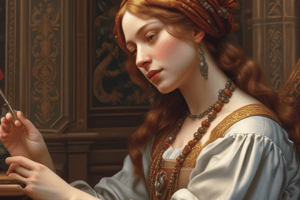Podcast
Questions and Answers
What was a primary shared interest between the Italian and Northern Renaissances?
What was a primary shared interest between the Italian and Northern Renaissances?
- Adherence to strict Byzantine iconographic traditions.
- An emphasis on abstract expressionism and subjective interpretation.
- Replicating classical Greek sculptures in bronze.
- Re-creating the illusion of reality and focusing on the natural world. (correct)
During the 15th century, which region, now encompassing Belgium, the Netherlands, and Luxembourg, was under the control of the Dukes of Burgundy?
During the 15th century, which region, now encompassing Belgium, the Netherlands, and Luxembourg, was under the control of the Dukes of Burgundy?
- The Papal States
- The Iberian Peninsula
- The Burgundian Netherlands (correct)
- The Holy Roman Empire
Besides the court, which group increasingly commissioned art in the Northern Renaissance, driven by growing interest in private devotion?
Besides the court, which group increasingly commissioned art in the Northern Renaissance, driven by growing interest in private devotion?
- Guilds of artisans and craftsmen
- Monasteries seeking to decorate their cloisters
- Newly wealthy private citizens (correct)
- The declining feudal aristocracy
How did Northern Europe's access to ancient monuments compare to that of Italy during the Renaissance?
How did Northern Europe's access to ancient monuments compare to that of Italy during the Renaissance?
What innovation in painting technique was most characteristic of artists in the North?
What innovation in painting technique was most characteristic of artists in the North?
What best describes the relationship between the spiritual and the material in Northern Renaissance art?
What best describes the relationship between the spiritual and the material in Northern Renaissance art?
What factor contributed to the flourishing artistic production in Bruges, Ghent, Antwerp and Brussels in Northern Europe?
What factor contributed to the flourishing artistic production in Bruges, Ghent, Antwerp and Brussels in Northern Europe?
How did the use of oil paint contribute to the Northern Renaissance artists' ability to depict reality?
How did the use of oil paint contribute to the Northern Renaissance artists' ability to depict reality?
What was the primary artistic influence in Italy during the Renaissance?
What was the primary artistic influence in Italy during the Renaissance?
Which of the following best describes the role of patrons like the Dukes of Burgundy during the Northern Renaissance?
Which of the following best describes the role of patrons like the Dukes of Burgundy during the Northern Renaissance?
Flashcards
Northern Renaissance
Northern Renaissance
A period in northern Europe sharing interests with the Italian Renaissance in naturalism and realistic depiction, though distinct in its sources and style.
Burgundian Netherlands
Burgundian Netherlands
The fifteenth-century region encompassing modern-day Belgium, the Netherlands, and Luxembourg, then under the rule of the wealthy Dukes of Burgundy.
Patrons of the Arts
Patrons of the Arts
Wealthy individuals or groups who commissioned art, playing a crucial role in the flourishing of artistic production.
Oil Glazes
Oil Glazes
Signup and view all the flashcards
Bruges, Ghent, Antwerp, Brussels
Bruges, Ghent, Antwerp, Brussels
Signup and view all the flashcards
Private Meditation and Prayer
Private Meditation and Prayer
Signup and view all the flashcards
Study Notes
- Art has the power to transform lives and build understanding across cultures.
- Smarthistory provides free, high-quality educational resources for art and cultural heritage.
- Smarthistory has 503 contributors from 201 colleges, universities, museums, and research centers.
- It is the most-visited art history resource in the world.
- The Italian and Northern Renaissances shared an interest in the natural world.
- They both aimed at re-creating the illusion of reality in paintings and sculptures.
- In the 15th century, Belgium, the Netherlands, and Luxembourg were controlled by the wealthy Dukes of Burgundy.
- This region is referred to as the Burgundian Netherlands.
- The court of the Dukes of Burgundy and newly wealthy private citizens commissioned art.
- This reflected a growing interest in private meditation, prayer, and portraiture.
- Like Florence, Bruges, Ghent, Antwerp and Brussels were rich industrial and banking centers.
- This allowed a large merchant-class to flourish creating an ideal environment for artistic production.
- The Italian Renaissance was influenced by the art and culture of Ancient Greece and Rome.
- Northern Europe drew more directly from medieval traditions, such as manuscript illuminations.
- Northern artists fully exploited the unique characteristics of oil paint.
- Using thin layers of paint, called glazes, artists created a depth of color that was entirely new.
- Oil paint can imitate textures better than fresco or tempera.
- This made it perfectly suited to representing the material reality.
- Artists created the illusion of light reflecting on metal surfaces or jewels, and textures that appear like real fur, hair, wool or wood.
- The representation of wealth and power were hugely important for patrons whether a pope, a duke, or a banker.
Studying That Suits You
Use AI to generate personalized quizzes and flashcards to suit your learning preferences.
Description
Italian and Northern Renaissances shared an interest in the natural world. They both aimed at re-creating the illusion of reality in paintings and sculptures. In the 15th century, Belgium, the Netherlands, and Luxembourg were controlled by the wealthy Dukes of Burgundy.




